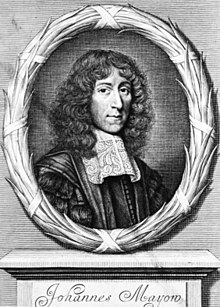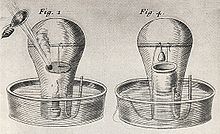John Mayow
John Mayow (born May 24, 1640 [according to Encyclopedia Britannica; according to other sources between 1641 and 1643] in Cornwall , † September 1679 in London ) was a British doctor, chemist and physiologist .
Live and act
Both the place of birth and the year of birth are not precisely determined, however the extensive research by Donald, F. Proctor suggests the following data; Mayow was born near Morval in Cornwall in 1641 . He was the second son of Phillip Mayowe (approx. 1600–1679) and his wife Frances Stukley, who had been married since November 22, 1635. He entered Wadham College , Oxford at the age of seventeen in 1658 . In 1660 he received a scholarship to The College of All Souls of the Faithful Departed at Oxford. There in Oxford he first studied law and graduated in 1665 with a bachelor's degree, bachelor of common law . Then followed the study of medicine, which he finished in 1670. He practiced as a doctor from 1670 to 1679 in the city of Bath in the summer and in London in the autumn and winter. In 1678 he was elected a member of the Royal Society on the proposal of Robert Hooke .
He died in London and was buried in St. Paul's Church in Covent Garden .
In his dissertation in 1669 he gave explanations for breathing and for combustion processes. After receiving his doctorate in 1670, he worked as a doctor and naturalist. He was of the opinion that air consists of two parts, one part of which is necessary for breathing to be alive. Mayow differentiated first between two qualitatively different proportions of the air, the proportion was essential need for creating an appearance of flame or combustion he called "Salpeterluft" or "fire air" or spirit nitro-Aereus (or spiritus vitalis ) because it in saltpetre as whose active or fiery component would appear (but in this it had a forerunner in Ralph Bathurst in Oxford 1654). This spiritus nitro-aëreus should enable combustion, be important for breathing and be a component of acids . In 1674 he described the formation of metal limestone as a union of metals with "saltpeter air", the spiritus nitro-aëreus .
Works (selection)
- Tractatus de respiratione et de rachitide. (1669)
- Tractatus Quinque Medico-Physici. (1674) Textarchiv - Internet Archive
- Opera omnia medico-physica. (1681)
- Tractus de sal-nitro et spiritu nitro-aëreo. Oxford, (1669)
- Investigations into saltpeter and the nitrous spirit of the air, burning and breathing . Edited by FG Donnan . Engelmann, Leipzig 1901 (Ostwald's Classics of Exact Sciences, 125)
literature
- Walter Reuter: The physiological conceptions of John Mayow and their significance for the development of physiology . Münster (Westphalia), Univ., Diss., 1950
- JR Partington : The life and work of John Mayow (1641-1679) . In: Isis . 47, No. 149, 1956, pp. 217-230. doi : 10.1086 / 348501 . PMID 13366533 .
- JR Partington: Some early appraisals of the work of John Mayow . In: Isis . 50, No. 3, 1959, pp. 211-226. doi : 10.1086 / 348773 . PMID 14430648 .
- W. Boehm: John Mayow and Descartes . In: Sudhoff's archive for the history of medicine and the natural sciences . 46, 1962, pp. 45-68. PMID 13870464 .
- GL Sternbach, J. Varon: Resuscitation Great. John Mayow and oxygen . In: Resuscitation . 60, No. 3, 2004, pp. 235-237. doi : 10.1016 / j.resuscitation.2003.12.013 . PMID 15050753 .
- JJ Beringer: John Mayow: Chemist and Physician . In: Royal Institution of Cornwall (ed.): Journal of the Royal Institution of Cornwall . IX, pp. 319-324. Retrieved February 12, 2008.
- Alexander Crum Brown: Dr. John Mayow: The Harveian Oration for 1899 . In: YJ Pentland. (Ed.): Edinburgh Medical Journal . 6, 1899, pp. 116-129. Retrieved February 10, 2008.
- John Mayow: Medico-physical Works: Being a translation of Tractatus Quinque Medico-physici . The Alembic Club, Edinburgh 1908 (Retrieved February 11, 2008). (1674)
- Donald F. Proctor: A History of Breathing Physiology . Marcel Dekker, Inc., New York 1995, ISBN 0-8247-9653-5 (accessed February 11, 2008).
- GL Sternbach, J. Varon: Resuscitation Great. John Mayow and oxygen . In: Resuscitation . 60, No. 3, 2004, pp. 235-237. doi : 10.1016 / j.resuscitation.2003.12.013 . PMID 15050753 .
- Max Speter: John Mayow and the fate of his teachings. Otto v. Halem, (1910)
- Mayow, John . In: Encyclopædia Britannica . 11th edition. tape 17 : Lord Chamberlain - Mecklenburg . London 1911, p. 938 (English, full text [ Wikisource ]).
Web links
- John Mayo. In: The Galileo Project.
- Uwe Mortensen: Theory of Science II. The beginning of experimental science . (PDF; 41.0 MB) WS 2004/05 Department of Psychology and Sports Science, Institute III, Westfälische Wilhelms-Universität. Last change: February 26, 2012, p. 76.
Individual evidence
- ^ Proctor, Donald F .: A History of Breathing Physiology. Marcel Dekker, Inc., New York (1995) ISBN 0-8247-9653-5
- ↑ World Connect Project
- ↑ JL Vivian; Henry H. Drake (Ed.): The visitation of the county of Cornwall, in the year 1620 . (PDF; 24.9 MB) London 1874
- ↑ Biography of John Mayow
- ↑ Elizabeth Ströker : theory change in the history of science. Vittorio Klostermann, Frankfurt am Main (1982) ISBN 3-465-01496-0 , p. 73
- ↑ Claus Priesner, Karin Figala: Alchemy. Lexicon of a Hermetic Science. Beck, Munich (1998) ISBN 3-406-44106-8 p. 312
| personal data | |
|---|---|
| SURNAME | Mayow, John |
| ALTERNATIVE NAMES | Mayowe, John |
| BRIEF DESCRIPTION | English physiologist and chemist |
| DATE OF BIRTH | May 24, 1640 |
| PLACE OF BIRTH | Cornwall |
| DATE OF DEATH | September 1679 |
| Place of death | London |

